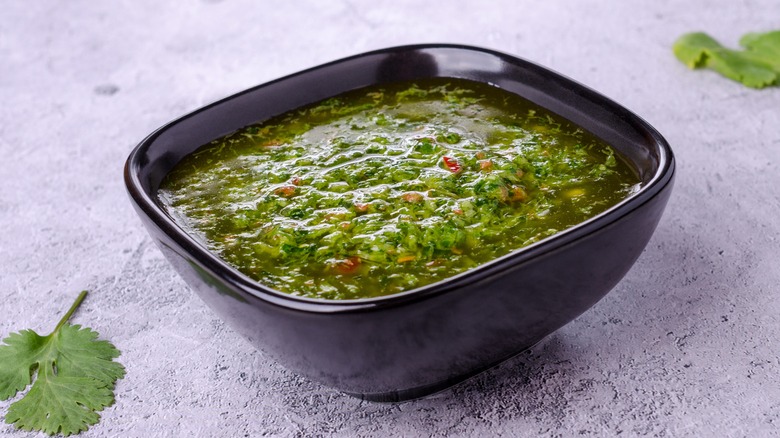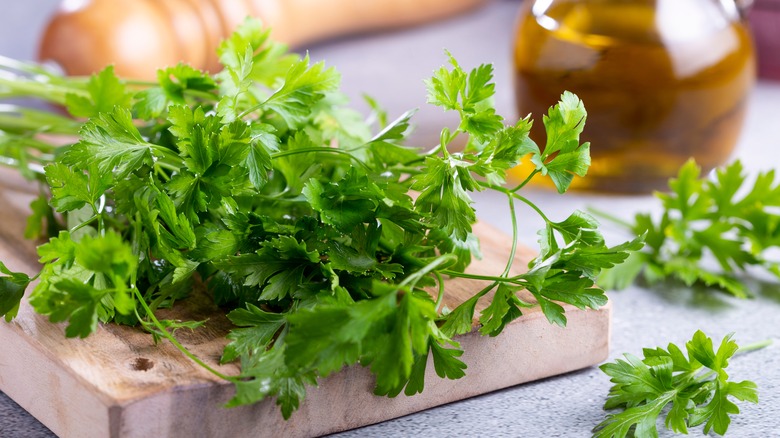Italy's Salsa Verde Is A Salty Sauce You Should Know About
While in North America, the name salsa verde normally conjures the classic Mexican tomatillo-based salsa, there is a whole world of "salsa verde" out there, from a simple chimichurri to the French purée of herbs, sauce verte, to an Italian style that's also confusingly named salsa verde. While it may not be as well-known as the Mexican version over here, the Italian salsa verde is one of the best variations on the formula, with a delicious and distinct tangy flavor that's just as versatile as the other classic sauces it shares a name with. Made with parsley, garlic, and olive oil, it shares some clear characteristics with other salsa verdes, and then adds its own twists with items like capers and lemon juice, which help create that unique, briny taste.
Italy's salsa verde originates from the northwestern region of Piedmont. It has a common heritage with Italy's other great salsa verde, pesto, which comes from Liguria on the coast to the south, a region that also contributed some of salsa verde's key ingredients. The salsa verde of Italy is noticeably funky, tangy, and salty, coming not just from capers or lemon juice, but from anchovies, which were traded up into Piedmont from the coast. Combine all that with some of the famous Ligurian olive oil pesto is also made with, and you have a rich, pungent sauce with an umami depth other salsa verde options just don't offer.
How to make Italian salsa verde
There are quite a few different variations on Italian salsa verde, but the core ingredients are always the same: Good olive oil is mixed with garlic, parsley, capers, and anchovies. The capers and anchovies make it distinct from parsley-based chimichurri, and there are no green tomatillos like the Mexcian style. Italian salsa verde is more uniform and creamy than some other styles too, so it's best made by mixing in a food processor or with an immersion blender. If you are making it by hand, mince the ingredients very finely to get that uniform consistency, then beat them with the olive oil using a whisk to emulsify, or pound them together using a mortar and pestle.
For different variations on salsa verde, there are a few simple additions that are traditional in Italy, which you can make depending on your tastes. If you want a more substantial, creamy texture, thickening agents like breadcrumbs or hard-boiled eggs are sometimes used. Lemon juice and zest are also common additions that will give salsa verde an extra citrusy zing, or you can get more bite from a few dashes of vinegar. Some red pepper flakes or chopped Calabrian chiles will give it a nice heat. And, of course, you don't need to limit yourself to parsley for the herb, although it should remain the primary one. Chives or basil can add some extra vegetal brightness, and fresh tarragon or oregano will bring more depth.
Using Italian salsa verde
Being bright, tangy, and salty, there aren't too many dishes salsa verde wouldn't work with, but there are some spots where it really shines. As usual, its traditional uses offer some great guidance. Salsa verde is popular as a topping for boiled meat, as it really wakes those hearty flavors up, and any simple grilled steak or braised pork would benefit from the same treatment. You can even use salsa verde as a marinade for meat, especially if you are adding vinegar or lemon juice that will help tenderize it. Salsa verde is also spread on otherwise unadorned toasted bread like crostini, or on a slice of cheese. And if you saw bread and cheese, you also know some salsa verde on fresh Neapolitan pizza would be great.
If you want to branch out, just think of any dishes that could use some zip and some salt and you'll be happy. Roasted vegetables or potatoes will be transformed into something much more lively, and fish or scallops will be right at home with the briny accompaniment. And even though it differs from other salsa verdes, you can still use them as a guide for where to try it out. Do you like huevos verdes? Italian salsa verde would be great over eggs. Are you enamored with pesto as a sandwich spread? You see where we're going. Italian salsa verde really is one of those condiments where the only limit is your tastes and your imagination.


